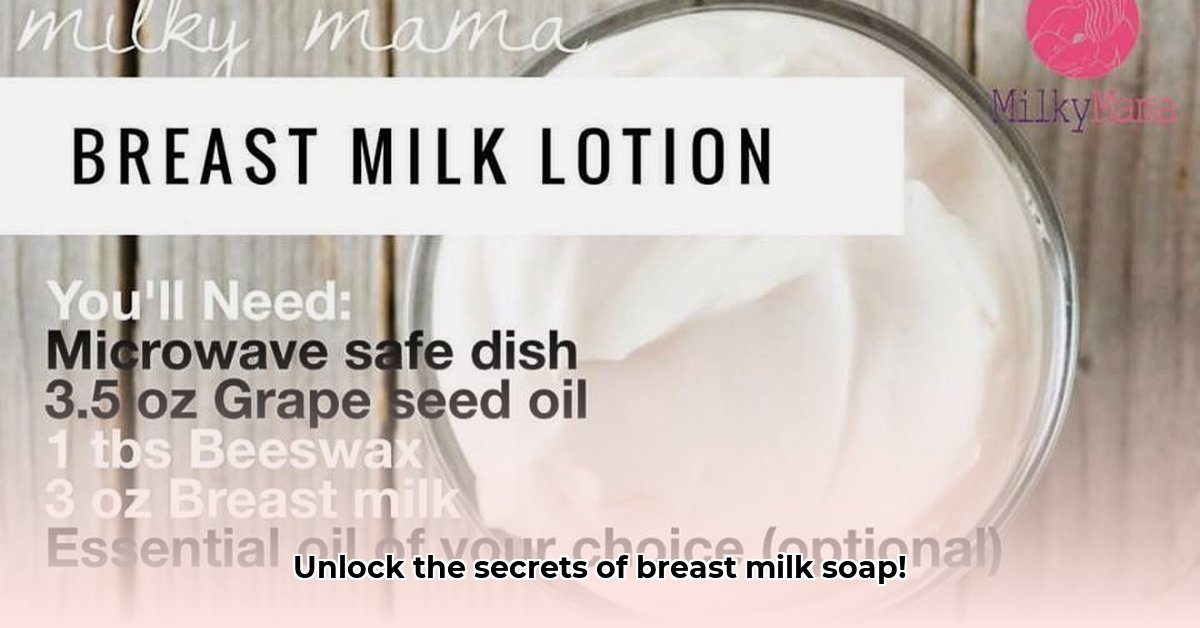
Understanding Breast Milk Soap
Have you considered transforming your breast milk into soap? While anecdotal evidence suggests potential benefits for sensitive skin, it's crucial to approach this with a balanced perspective. This guide provides clear instructions for safe and effective breast milk soap making, alongside realistic expectations about its purported advantages.
The Science Behind Soap Making
Soap making, or saponification, involves a chemical reaction between fats (in your breast milk) and lye (a strong alkali). This process neutralizes the lye, creating soap. However, this process significantly alters breast milk's composition. Many beneficial components, such as antibodies, are likely diminished or lost. Therefore, claims about significant health benefits are largely unsubstantiated. More research is needed to fully understand the impact of saponification on breast milk's properties. Is this chemical transformation something that concerns you?
Safety First: Lye Handling
Lye is caustic and can cause severe burns. Safety is paramount. Always wear safety glasses, long sleeves, and gloves that extend to your elbows when handling lye. Work in a well-ventilated area, such as an outdoor space or a room with an exhaust fan. Never substitute lye with another substance, and always use only your breast milk — donated milk poses significant contamination risks. Have you considered undergoing some beginner soapmaking classes or workshops before proceeding with production?
Two Methods for Breast Milk Soap Making
We'll explore two methods: melt and pour (simpler) and cold process (more involved).
Method 1: Melt and Pour (Beginner-Friendly)
This method uses a pre-made soap base, simplifying the process.
Steps:
- Melt the soap base according to package instructions.
- Add your room-temperature breast milk (follow recipe guidelines).
- Gently stir in essential oils (optional; select skin-safe options).
- Pour into molds and allow to cool completely.
- Unmold and enjoy!
Note: Melt and pour soaps typically have shorter shelf lives (6-12 months) and may be more prone to rancidity.
Method 2: Cold Process (Advanced)
This method involves directly mixing oils and lye. Thorough research and understanding of safety protocols are crucial. Improper lye handling can result in serious injury. It provides more control over ingredients and results in a longer-lasting soap. Numerous resources are available for learning cold-process soapmaking.
Steps:
- Carefully measure lye and water using a lye calculator (https://soapcalc.net/).
- Slowly add the lye solution to your oils (including breast milk).
- Blend until it reaches trace.
- Pour into molds; cover and let cure for several days.
Troubleshooting and FAQs
- Rancidity: Proper storage (cool, dark, dry, airtight container) is key to preventing rancidity.
- Soap Separation: This suggests an error in the process. Refer to reliable soapmaking resources.
- Discoloration: Variations in color are natural; don't be alarmed.
- Essential Oil Use: Always perform a patch test to check for allergies.
Shelf Life: Melt and pour soaps last 6-12 months; cold process soaps can last 1-2 years, provided storage is proper.
Legal and Ethical Considerations
The FDA regulates soap labeling. Avoid making unsubstantiated health claims. Always use your own breast milk.
Is Breast Milk Soap Right for You?
Consider the pros (potential moisturizing benefits, natural feel) and cons (unproven health claims, shorter shelf life for melt-and-pour) before deciding. Safety should always be your top priority.
Extending Shelf Life
Proper storage (cool, dark, dry, airtight) significantly impacts shelf life. Cold-process soaps, due to complete saponification, generally have longer shelf lives. Discard soap if it shows signs of rancidity.
Key Takeaways:
- Homemade breast milk soap is a unique skincare option.
- Two methods exist: melt-and-pour (simple) and cold-process (advanced).
- Proper storage significantly extends shelf life.
- Lye handling requires stringent safety measures.
- Accurate labeling and avoiding unsubstantiated health claims are crucial.